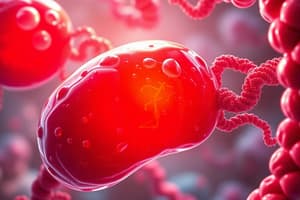Podcast
Questions and Answers
What is the role of hemoglobin in the body?
What is the role of hemoglobin in the body?
- Regulating heart rate and blood pressure
- Assisting in blood clotting mechanisms
- Transporting carbon dioxide from the lungs to the tissues
- Carrying oxygen from the tissues back to the lungs (correct)
How is hemoglobin production regulated in the body?
How is hemoglobin production regulated in the body?
- By erythropoietin (EPO) and transcription factors (correct)
- Through the production of glucagon
- By thyroid hormone regulation
- By insulin secretion
Which statement about the structure of hemoglobin is correct?
Which statement about the structure of hemoglobin is correct?
- The beta chains contain additional repeats of a motif compared to the alpha chains (correct)
- It is composed of four beta chains
- The alpha chains have motifs absent in the beta chains
- Its structure allows it to bind and release nitrogen effectively
How does hemoglobin respond to changes in pH and temperature?
How does hemoglobin respond to changes in pH and temperature?
What stimulates the production of red blood cells, ultimately leading to hemoglobin synthesis?
What stimulates the production of red blood cells, ultimately leading to hemoglobin synthesis?
Why is hemoglobin crucial for maintaining homeostasis in the body?
Why is hemoglobin crucial for maintaining homeostasis in the body?
What is the function of hemoglobin in the body?
What is the function of hemoglobin in the body?
Which statement about hemoglobin's affinity for oxygen is correct?
Which statement about hemoglobin's affinity for oxygen is correct?
In what environment do hemoglobin molecules transition into a higher oxygen affinity state?
In what environment do hemoglobin molecules transition into a higher oxygen affinity state?
How does the presence of carbon monoxide affect hemoglobin's affinity for oxygen?
How does the presence of carbon monoxide affect hemoglobin's affinity for oxygen?
Which component forms a quaternary structure with a heme group in hemoglobin?
Which component forms a quaternary structure with a heme group in hemoglobin?
Why is understanding the structure of hemoglobin crucial?
Why is understanding the structure of hemoglobin crucial?
Flashcards are hidden until you start studying
Study Notes
Hemoglobin
Hemoglobin is a protein molecule located within red blood cells (erythrocytes) that plays a crucial role in transporting oxygen from the lungs to the rest of the body and carbon dioxide from tissues back to the lungs. This protein contains four polypeptide chains of two different types – two alpha ((\alpha)) chains and two beta ((\beta)) chains – which together form a quaternary structure with a heme group attached to each (\alpha)-chain and a globin fold domain attached to each (\beta)-chain.
Oxygen Binding to Hemoglobin
The oxygen binding capacity of hemoglobin is governed by its affinity for oxygen, which varies depending on factors such as pH, temperature, and partial pressure of oxygen (pO2) in the environment. At high altitudes where there is low ambient pressure, the hemoglobin molecules transition into a higher oxygen affinity state, making them better suited to extract more oxygen from the air. In the presence of carbon monoxide, however, the hemoglobin's affinity for oxygen decreases, leading to hypoxia if levels are too high.
Structure of Hemoglobin
Although the exact three-dimensional structure of human hemoglobin has been determined through X-ray crystallography, understanding its structure is crucial for explaining its functions and developing treatments for diseases caused by mutations in its components. The protein consists of four polypeptide chains: two identical (\alpha) chains and two identical (\beta) chains. Each chain folds into a complex three-dimensional structure called the globin fold. Within this fold, the amino acid sequences of the (\beta) chains contain additional repeats of a motif that is absent in the (\alpha) chains.
Role of Hemoglobin in the Body
Hemoglobin plays a vital role in the body's respiratory system, carrying oxygen from the lungs to the tissues and carbon dioxide from the tissues back to the lungs. This process is essential for maintaining homeostasis by providing oxygen for cellular respiration and removing carbon dioxide produced by cellular metabolism.
Regulation of Hemoglobin Production
The production of hemoglobin is regulated by the body through several mechanisms. One of these is the production of erythropoietin (EPO), a hormone produced by the kidneys in response to low oxygen levels in the tissues. EPO stimulates the production of red blood cells, which in turn produce hemoglobin. Another mechanism involves the regulation of hemoglobin synthesis at the transcriptional level, where the activity of transcription factors such as GATA1 and KLF1 is critical for the production of hemoglobin.
Function of Hemoglobin
In summary, hemoglobin is a protein molecule responsible for transporting oxygen and carbon dioxide in the body. Its structure, composed of two alpha chains and two beta chains, allows it to bind and release oxygen in response to changes in pH, temperature, and oxygen concentration. Hemoglobin's production is regulated by various mechanisms, including erythropoietin (EPO) and transcription factors, and its function is crucial for maintaining homeostasis by delivering oxygen to tissues and removing carbon dioxide.
Studying That Suits You
Use AI to generate personalized quizzes and flashcards to suit your learning preferences.




